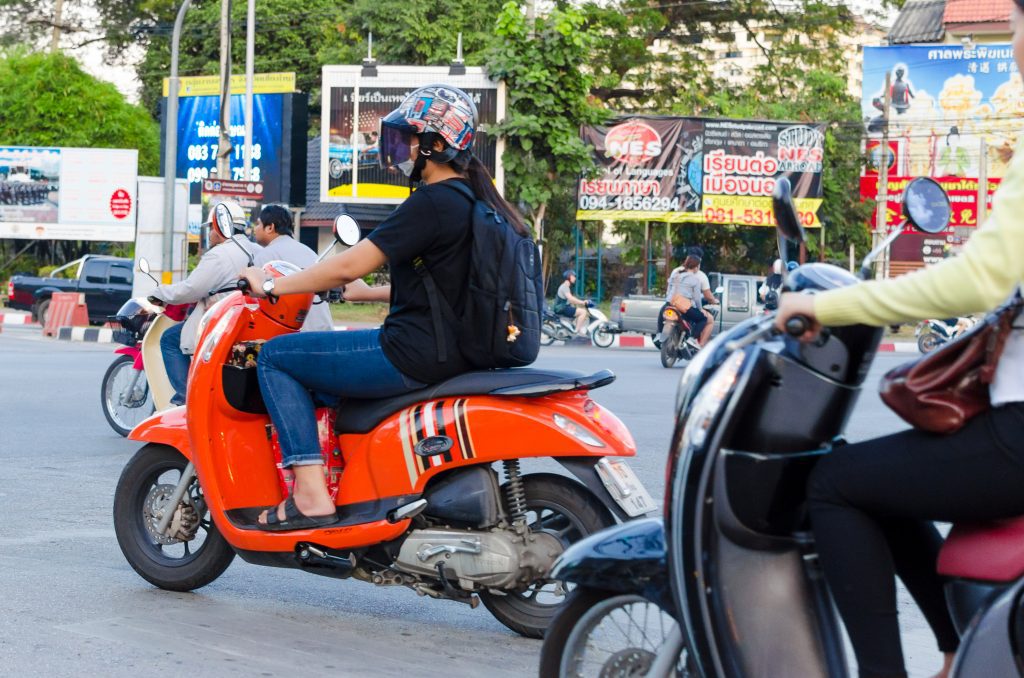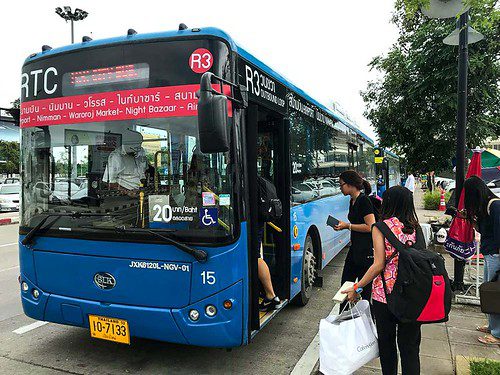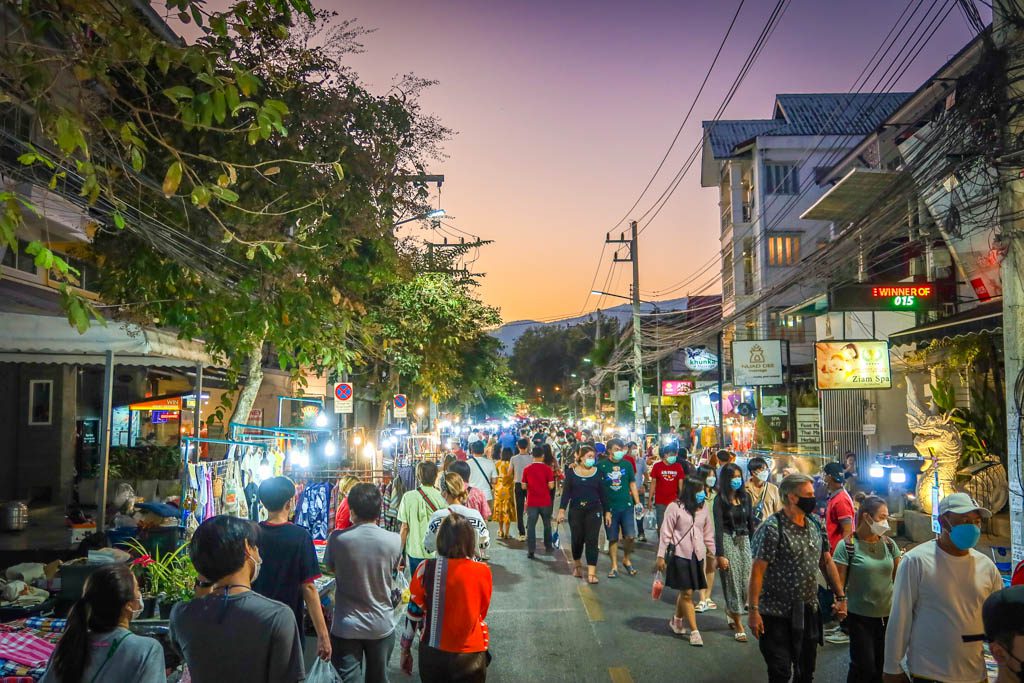Chiang Mai, a city renowned for its cultural richness and scenic beauty, has a diverse transportation landscape that caters to the needs of locals and visitors alike. Understanding how to navigate this Northern Thai city efficiently and safely is crucial for a smooth and enjoyable experience.
Overview of the Transportation Landscape in Chiang Mai
Tuk-Tuks and Songthaews: The most iconic modes of transportation in Chiang Mai are tuk-tuks (three-wheeled taxis) and songthaews (red pick-up trucks that function as shared taxis). They are easily found throughout the city and are ideal for short distances.
Taxis and Ride-Hailing Services: Metered taxis are available, though less common than in Bangkok. Ride-hailing services like Grab are also operational in Chiang Mai and can be a convenient option for getting around.
Bicycle and Scooter Rentals: For those comfortable with self-navigation, renting bicycles or scooters can be an excellent way to explore the city and its outskirts. It offers flexibility but requires caution due to traffic and road conditions.
Public Buses: Recently introduced, the RTC (Chiang Mai Smart Bus) offers air-conditioned buses with several routes covering major attractions and areas in the city.
Understanding the City Layout and Key Areas for Visitors
Chiang Mai’s city layout is relatively straightforward:
Old City: The center of Chiang Mai, defined by moats and ancient walls, is a key area where many temples, markets, and guesthouses are located. It’s easily navigable on foot or by bicycle.
Nimmanhaemin and Surrounding Areas: Known for its trendy cafes, restaurants, and boutiques, the Nimman area is just a short ride from the Old City.
Riverside and Night Bazaar Area: East of the Old City, along the Ping River, this area is famous for its evening market and dining options.
General Tips for Safe and Efficient Navigation
Familiarize with the Layout: Spend some time understanding the city’s layout. The Old City’s square shape and the main roads around it make for easy navigation.
Agree on Fares in Advance: For tuk-tuks and songthaews, it’s advisable to agree on the fare before starting your trip to avoid any confusion later.
Be Cautious if Self-Driving: If renting a scooter or a bike, ensure you’re comfortable with the traffic rules and conditions. Always wear a helmet.
Use Technology: Smartphone apps for maps and transportation can be incredibly helpful for planning routes and estimating travel times.
Stay Hydrated: Chiang Mai can be hot, especially during the day, so carry water with you during your travels.
Respect Local Etiquette: When using public transport, be mindful of local customs and etiquette, such as removing shoes when entering certain vehicles like tuk-tuks.
Navigating Chiang Mai’s transportation system can be part of the adventure of exploring this vibrant city. With a mix of traditional and modern modes of transport, visitors can choose the option that best suits their comfort level and travel style. By planning and staying aware of safety practices, you can ensure a smooth and enjoyable experience getting around Chiang Mai.


Tuk-Tuks and Songthaews: The Local Way
Tuk-tuks and songthaews are quintessential elements of local transportation in Chiang Mai, offering an authentic and often exciting way to navigate the city. Understanding how to use them effectively, negotiate fares, and avoid common pitfalls is essential for any visitor.
The Ins and Outs of Using Tuk-Tuks and Songthaews
Tuk-Tuks: These are three-wheeled motorized vehicles, ideal for short distances and when you need a direct route. They’re more private than songthaews but usually cost more.
Songthaews: These are red pickup trucks with two rows of passenger seating in the back. They operate both as shared and private taxis. For shared rides, they follow general routes but not fixed schedules, and you can hop on and off along these routes.
Tips on Fares, Bargaining, and Avoiding Common Pitfalls
Negotiate Fares Upfront: Before getting into a tuk-tuk or a private songthaew, negotiate and agree on the fare. Prices can fluctuate based on the time of day, distance, and your bargaining skills.
Know the Average Rates: Familiarize yourself with average rates for common distances. This knowledge helps in negotiating fair prices.
Be Aware of Overcharging: Some drivers may quote inflated prices, especially to tourists. It helps to ask your hotel or local friends about reasonable fares for your intended route.
Use Small Bills: Have small denominations of Thai currency for payment, as drivers may not always have change for large bills.
When and Where to Use These Local Transport Options Effectively
Short and Direct Trips: Tuk-tuks are best for short, direct routes, especially when you’re in a hurry or traveling late at night when other options are less available.
Exploring Tourist Attractions: Many tuk-tuk drivers offer half-day or full-day rates for touring various attractions around the city.
Local Experiences and Longer Routes: Songthaews are great for longer distances within the city or for a more local experience. They’re cost-effective for individual travelers on shared routes.
Busy Areas and Tourist Spots: You’ll find plenty of tuk-tuks and songthaews around busy areas like the Old City, Night Bazaar, and major temples.
In summary, tuk-tuks and songthaews provide a fun and flexible way to explore Chiang Mai. They offer a glimpse into the local way of life, making every journey more than just a ride from one point to another. With some savvy negotiation and an understanding of how these services operate, you can navigate the city efficiently while enjoying the unique charm of these local transport methods.


Renting Scooters and Motorbikes
Renting scooters or motorbikes in Chiang Mai can be an excellent way to explore the city and its surrounding areas at your own pace. However, it’s crucial to be informed about the rental process, adhere to safety guidelines, and understand local traffic laws to ensure a safe and enjoyable experience.
Guidelines for Renting Scooters and Motorbikes in Chiang Mai
Valid License: Ensure you have a valid driver’s license from your home country and an International Driving Permit (IDP). Thai law requires foreign drivers to have an IDP along with their national license.
Rental Agreement: Read the rental agreement carefully. Understand the terms, especially regarding insurance coverage and what happens in case of damage or theft.
Inspect the Vehicle: Before renting, inspect the scooter or motorbike for any existing damage. Take photos or videos as proof to avoid disputes when returning the vehicle.
Rental Duration: Decide beforehand how long you need the rental. Rates can vary for daily, weekly, or monthly rentals.
Essential Safety Advice and Local Traffic Laws
Wear a Helmet: Always wear a helmet – it’s the law in Thailand and crucial for your safety.
Understand Traffic Rules: Familiarize yourself with local traffic laws. Remember, in Thailand, driving is on the left side of the road.
Avoid Busy Areas if Inexperienced: If you’re not an experienced rider, avoid busy areas like the Old City and main highways.
Be Alert: Traffic in Chiang Mai can be unpredictable. Watch out for other vehicles, pedestrians, and occasional stray animals.
No Drinking and Driving: Never drive under the influence of alcohol or drugs.
Recommended Rental Companies and What to Look for in a Rental
Reputable Companies: Choose well-reviewed rental companies such as Mr. Mechanic, Mango Bikes Rent, or Tony’s Big Bikes.
Condition of the Bike: Check that the scooter or motorbike is in good working condition. Pay attention to the brakes, lights, and tires.
Insurance: Verify what kind of insurance is offered. Some rentals include basic insurance, but you might want to consider additional coverage.
Rental Inclusions: Check if the rental includes helmets, a lock, or a storage box.
Support Services: Ask about services in case of breakdown or emergency. Some rentals offer 24-hour assistance.
Renting a scooter or motorbike in Chiang Mai can be a thrilling way to discover the city’s hidden treasures and scenic countryside. However, prioritizing safety and being well-informed about the rental process is key. Always ride responsibly and enjoy the freedom and flexibility that comes with having your own set of wheels.


Public Buses and Taxi Services
Navigating Chiang Mai can be an enjoyable experience with the city’s public buses and taxi services. These transportation options offer convenience and a local experience, whether you’re exploring the city’s historical sites or venturing into its vibrant neighborhoods.
Navigating Chiang Mai with Public Buses: Routes and Tips
RTC City Bus: Chiang Mai’s recent addition, the RTC (Regional Transit Corporation) City Bus, offers air-conditioned comfort and covers several main routes in the city. Key routes include service to popular areas like the Old City, Nimmanhaemin, and major shopping centers.
Bus Routes and Schedules: Familiarize yourself with bus routes and schedules. Information is usually available online, at bus stops, or directly from the bus driver.
Bus Fares: Fares are affordable, making this a budget-friendly option. Have small change ready for fares as bus drivers may not always have change for large bills.
Bus Etiquette: Like in many places, it’s polite to offer your seat to the elderly, pregnant women, or those with disabilities.
Using Taxi Services, Including Grab and Local Taxis
Metered Taxis: Metered taxis in Chiang Mai are less common than tuk-tuks or songthaews but can be found, especially around the airport, train station, and major hotels.
Ride-Hailing Services: Grab is widely used in Chiang Mai and can be a convenient way to book rides with transparent pricing. It offers both car and motorbike options.
Fares and Payment: For metered taxis, ensure the driver uses the meter. With Grab, the fare is fixed and known at the time of booking. Payment can usually be made in cash or via the app.
Booking: Taxis can be hailed on the street, but for a more convenient experience, booking via phone or ride-hailing apps is recommended.
Taxi Etiquette: It’s courteous to let the driver know your destination and ask about the fare (if not metered) before getting in.
Understanding Fares, Booking Methods, and Taxi Etiquette
Negotiate Fares for Non-Metered Rides: If the taxi doesn’t use a meter, agree on the fare before starting your journey.
Safety First: Always use reputable taxi services and avoid unmarked vehicles, especially late at night.
Have a Map Handy: It can be helpful to have a map or GPS app on your phone to assist with directions, particularly if there’s a language barrier.
Be Patient with Traffic: Traffic in Chiang Mai can be unpredictable, especially during peak hours, so factor in extra time for your travel.
By utilizing Chiang Mai’s public buses and taxi services, you can explore the city with ease and comfort. Each option offers its advantages, from the affordability of public buses to the convenience of taxis and ride-hailing services, making your travel experience in Chiang Mai both enjoyable and efficient.


Exploring Chiang Mai by bicycle: rental options and best routes
Exploring Chiang Mai by bicycle can be an exhilarating and intimate way to experience the city’s charm. It’s an excellent option for active travelers who wish to navigate the city at their own pace, delve into hidden alleys, and enjoy the vibrant street life up close. Here’s a guide to help you make the most out of your cycling adventure in Chiang Mai.
Bicycle Rental Options and Best Routes
Rental Options: Chiang Mai has numerous bike rental shops offering a range of bicycles from basic models to high-end road bikes. Popular rental places include Chiang Mai Bicycle, SpiceRoads, and Mountain Biking Chiang Mai.
Best Routes:
Old City Exploration: The square layout of Chiang Mai’s Old City makes it ideal for leisurely cycling. You can explore historic temples, local markets, and quaint cafes.
Riverside Route: Cycle along the Ping River for scenic views and a glimpse of local life along the riverbanks.
Nimmanhaemin and Surrounding Areas: For a more modern slice of Chiang Mai, the Nimman area offers trendy shops and eateries, best explored on two wheels.
Safety Tips for Cycling in the City
Wear a Helmet: Safety should always be a priority. Ensure you wear a helmet, regardless of the distance or route.
Follow Traffic Rules: Stick to the left side of the road, obey traffic signals, and be cautious at intersections.
Be Visible: Wear bright clothing and use lights if you plan to ride in the early morning or evening.
Stay Hydrated: Chiang Mai can be hot, especially during midday. Carry water to stay hydrated.
Lock Your Bike: Always secure your bike with a good lock when unattended.
Highlighting Bicycle-Friendly Areas and Attractions
Suan Buak Haad Park: A great spot to relax after a ride. The park is cyclist-friendly and offers a peaceful environment.
Doi Suthep-Pui National Park: For the more adventurous, this national park offers challenging but rewarding routes with stunning views.
Local Markets: Places like Warorot Market are accessible by bike, offering a colorful and authentic local shopping experience.
Cultural Sites: Many of Chiang Mai’s temples and museums are accessible by bicycle, providing a leisurely way to explore these sites.
Cycling in Chiang Mai not only promotes an active lifestyle but also offers an environmentally friendly way to explore the city. It allows for a deeper connection with the local environment and culture, offering an authentic travel experience. Just remember to cycle responsibly and respect both traffic rules and local customs for a safe and enjoyable journey.


Walking Around Chiang Mai
Exploring Chiang Mai on foot is a wonderful way to immerse yourself in the city’s vibrant culture, intricate architecture, and bustling street life. Walking allows you to take in the sights, sounds, and smells of the city at a leisurely pace, often leading to unexpected discoveries and interactions. Here are some tips for making the most of your pedestrian exploration in Chiang Mai.
Tips for Exploring Chiang Mai on Foot
Start Early or Late: To avoid the midday heat, plan your walking excursions early in the morning or later in the afternoon. The cooler temperatures make for a more comfortable experience.
Stay Hydrated: Carry a water bottle with you to stay hydrated, especially during the hot season. You’ll find plenty of cafes and street vendors to refill your bottle.
Wear Comfortable Shoes: Good walking shoes are essential. You’ll likely be navigating a variety of terrains, from smooth temple floors to uneven street pavements.
Plan Your Route: Map out your route in advance, but be flexible. Chiang Mai’s charm often lies in its unexpected nooks and crannies.
Sun Protection: Use sunscreen, wear a hat, and possibly sunglasses to protect yourself from the sun.
Pedestrian-Friendly Areas and Navigating Busy Streets
The Old City: Enclosed by ancient walls and a moat, the Old City is a pedestrian’s paradise. It’s home to famous temples, markets, and plenty of eateries.
Nimmanhaemin Road: Known for its modern cafes, art galleries, and boutiques, Nimmanhaemin and its surrounding sois (side streets) are great for exploring on foot.
Riverside Area: The area along the Ping River is perfect for leisurely strolls, especially in the evenings when the weather is cooler and the area comes alive with night markets and restaurants.
Busy Streets: On busier streets, be mindful of traffic and always use pedestrian crossings where available. Sidewalks can sometimes be crowded with vendors, so walking on the side of the road might be necessary – always be cautious of your surroundings.
Combining Walking with Other Modes of Transport for a Comprehensive Experience
Public Transport for Longer Distances: Use songthaews, tuk-tuks, or the RTC city bus for longer distances or when you’re heading outside the city center.
Bicycle Rentals: For areas a bit further out, consider renting a bicycle. Many areas in Chiang Mai are bike-friendly and offer a different perspective of the city.
Organized Walking Tours: Joining a guided walking tour can provide deeper insights into Chiang Mai’s history and culture, often covering areas and stories you might miss on your own.
Exploring Chiang Mai on foot is not just about seeing the sights; it’s about experiencing the rhythm of the city. Whether it’s strolling through the historic streets of the Old City, wandering through bustling markets, or enjoying the serene atmosphere of a temple, walking offers a direct and intimate way to connect with the heart of Chiang Mai.
Day Trips and Longer Journeys
Venturing outside of Chiang Mai opens up a world of diverse landscapes, cultural experiences, and historical sites. Whether you’re planning a short day trip or a longer journey, Northern Thailand offers a plethora of destinations accessible from Chiang Mai. Here’s a guide on transportation options and tips for planning your excursions.
Options for Traveling Outside Chiang Mai: Buses, Trains, and Car Rentals
Buses: For budget-friendly travel, buses are a great option. Chiang Mai’s Arcade Bus Station connects to various destinations like Pai, Chiang Rai, and Mae Hong Son. VIP buses offer more comfort for longer journeys.
Trains: Although slower, trains offer a scenic route to destinations like Bangkok and Ayutthaya. Overnight sleeper trains are an experience in themselves, offering a comfortable and picturesque journey.
Car Rentals: Renting a car gives you the flexibility to explore at your own pace. It’s ideal for accessing remote areas and tailoring your itinerary. International driving permits are required for foreign drivers.
Tips for Planning Day Trips and Excursions
Destination Research: Look into the highlights of each destination to prioritize your stops and activities. Consider travel time and opening hours of attractions.
Book in Advance: For popular destinations or activities, it’s wise to book tours or tickets in advance, especially during peak tourist seasons.
Pack Appropriately: Depending on your destination, pack essentials like water, snacks, sun protection, and appropriate clothing.
Local Guides: For certain areas, especially those with cultural or historical significance, hiring a local guide can enrich your experience.
Travel Insurance: Always travel with insurance, especially for activities like trekking, biking, or motorbiking in rural areas.
Important Considerations for Longer Journeys from Chiang Mai
Travel Time: Longer journeys require more planning. Check travel times and consider overnight stays to avoid rushing your experience.
Safety: Be aware of the road and weather conditions, especially during the rainy season. Remote areas may have less frequent transport services and fewer amenities.
Cultural Sensitivity: When visiting rural villages or hill tribes, be respectful of local customs and traditions. Responsible tourism is key in these areas.
Health Precautions: In more remote areas, access to medical facilities may be limited. Carry a basic first aid kit and any necessary medications.
Communication: In rural and remote areas, English may not be widely spoken. Having a basic grasp of Thai phrases or a translation app can be helpful.
Exploring beyond Chiang Mai allows you to experience the rich tapestry of Northern Thailand’s culture and natural beauty. Whether it’s the tranquil mountain towns, the vibrant local markets, or the historic ruins, each destination has its unique allure. With thoughtful planning and a sense of adventure, these excursions can become the highlight of your Thai journey.
Conclusion: Mastering Transport in Chiang Mai
Mastering the various modes of transport in Chiang Mai can significantly enhance your travel experience, allowing for smooth and hassle-free exploration of this culturally rich city. From the bustling streets of the Old City to the tranquil countryside, how you choose to get around can shape your experience and create lasting memories.
Summarizing Key Transport Tips for a Hassle-Free Exploration
Embrace Local Transport: Tuk-tuks and songthaews offer a quintessentially Thai experience and are great for short distances within the city.
Combine Walking with Transport: The compact size of Chiang Mai’s Old City makes it perfect for walking. Combine this with local transport for longer distances.
Rent Wisely: If you opt for renting scooters or bicycles, ensure you’re comfortable with local driving conditions. Always prioritize safety with helmets and adhere to traffic laws.
Plan for Longer Journeys: For day trips or journeys to neighboring towns, consider reliable options like buses, trains, or car rentals. Remember to book in advance for peak seasons.
Stay Informed and Flexible: Keep updated on local traffic and weather conditions, and remain flexible with your plans.
Encouraging Visitors to Choose Transportation Modes That Suit Their Comfort Levels and Travel Styles
Every traveler has unique preferences and comfort levels:
Adventure Seekers: For those who enjoy adventure, renting scooters or motorbikes can be an exhilarating way to explore the city and its surroundings.
Culture Enthusiasts: If you’re keen on immersing yourself in local culture, tuk-tuks, songthaews, and walking offer more interactive experiences.
Relaxed Travelers: For a more relaxed pace, using taxis or ride-hailing services like Grab ensures comfort and ease.
Final Thoughts on Enjoying the Journey as Much as the Destination in Chiang Mai
Transport in Chiang Mai is not just a means to an end; it’s part of the adventure. The journey through the city’s streets, whether it’s on the back of a songthaew, the seat of a bicycle, or a leisurely stroll, allows you to absorb the sights, sounds, and rhythms of Chiang Mai. Each mode of transport offers a different perspective of the city, from up-close glimpses of daily life to panoramic views of its stunning landscapes.
In conclusion, the key to a fulfilling travel experience in Chiang Mai lies in choosing transportation methods that align with your interests and comfort level. Embrace the local way of life, plan wisely, and remember to enjoy every moment of your journey in this beautiful city. Chiang Mai’s charm often lies as much in its journey as in its destinations.








